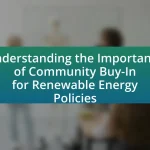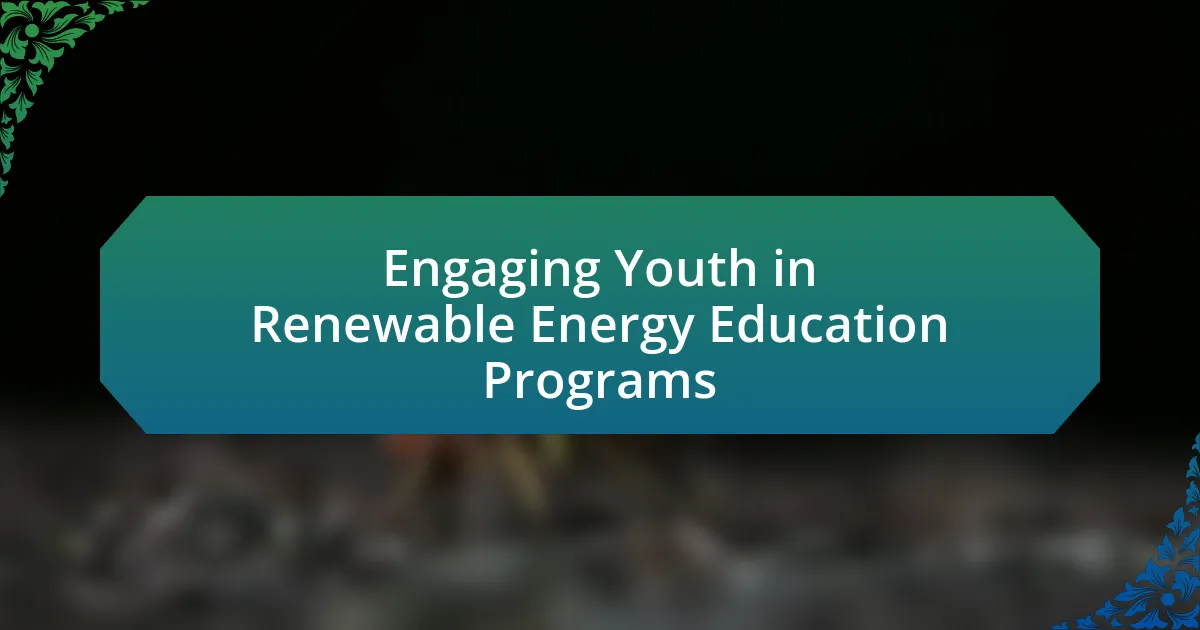The article focuses on fostering partnerships between nonprofits and renewable energy initiatives, emphasizing key elements such as shared goals, effective communication, resource alignment, and mutual benefits. It explores how these organizations align their missions around sustainability and community welfare, highlighting common goals and complementary missions. The article also discusses potential benefits of these partnerships, strategies for building effective collaborations, and challenges that may arise, including funding limitations and differing organizational cultures. Additionally, it provides practical tips for nonprofits to engage with renewable energy initiatives and ensure sustainable partnerships.
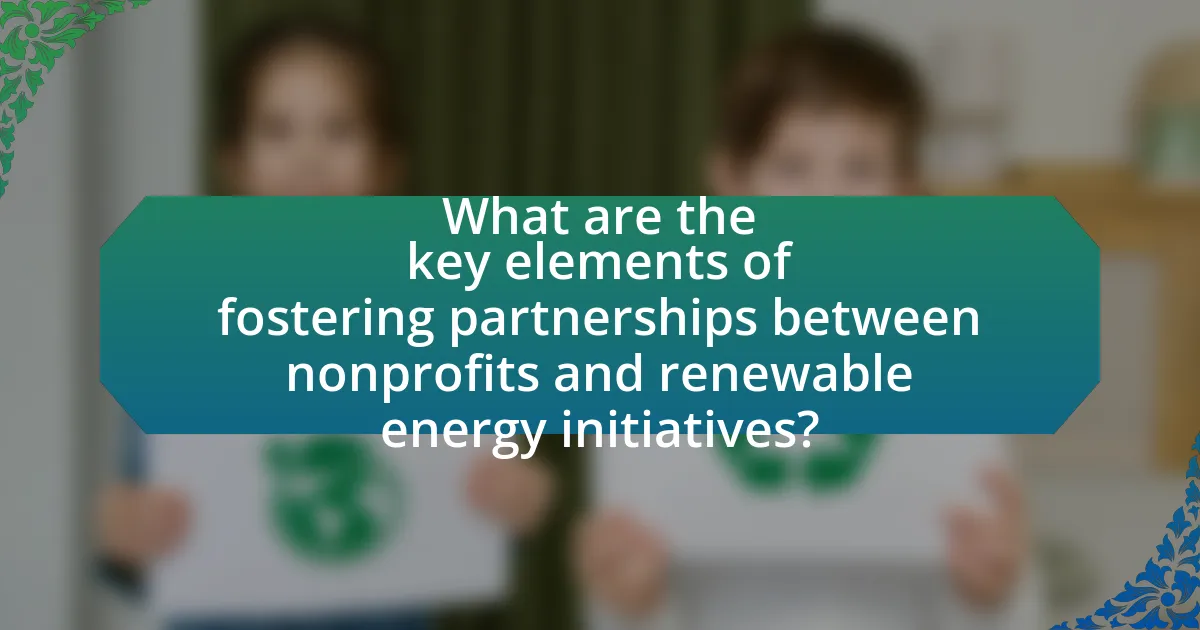
What are the key elements of fostering partnerships between nonprofits and renewable energy initiatives?
The key elements of fostering partnerships between nonprofits and renewable energy initiatives include shared goals, effective communication, resource alignment, and mutual benefits. Shared goals ensure that both parties are working towards a common vision, such as promoting sustainability or increasing access to renewable energy. Effective communication facilitates transparency and trust, allowing for the exchange of ideas and feedback. Resource alignment involves matching the strengths and capabilities of each partner, such as funding, expertise, or community connections, to enhance project outcomes. Finally, mutual benefits create a win-win situation, where both nonprofits and renewable energy initiatives gain value, whether through increased visibility, funding opportunities, or enhanced community impact. These elements are critical for successful collaboration and achieving long-term sustainability in renewable energy efforts.
How do nonprofits and renewable energy initiatives align in their missions?
Nonprofits and renewable energy initiatives align in their missions through a shared commitment to sustainability and community welfare. Nonprofits often focus on social equity, environmental protection, and community development, while renewable energy initiatives aim to reduce carbon emissions and promote clean energy solutions. This alignment is evident in collaborative projects that seek to provide affordable energy access to underserved communities, thereby enhancing quality of life and fostering economic development. For instance, organizations like GRID Alternatives work to install solar energy systems for low-income families, demonstrating how these missions intersect to create tangible benefits for communities.
What common goals do they share?
Nonprofits and renewable energy initiatives commonly share the goal of promoting sustainability and environmental stewardship. Both entities aim to reduce carbon footprints and enhance community resilience through clean energy solutions. For instance, nonprofits often advocate for renewable energy policies and practices, while renewable energy initiatives seek to implement these solutions effectively, thereby aligning their missions to create a more sustainable future. This collaboration can lead to increased public awareness and support for renewable energy projects, ultimately contributing to broader environmental goals.
How can their missions complement each other?
Nonprofits and renewable energy initiatives can complement each other by aligning their missions towards sustainable development and community empowerment. Nonprofits often focus on social issues such as poverty alleviation and environmental justice, while renewable energy initiatives aim to provide clean energy solutions that can enhance quality of life. For instance, a nonprofit working on community health can partner with a solar energy initiative to provide affordable energy solutions, thereby improving health outcomes through better access to electricity. This synergy not only addresses immediate social needs but also promotes long-term sustainability, as evidenced by projects like the Solar Electric Light Fund, which combines renewable energy with community development efforts.
What are the potential benefits of these partnerships?
Partnerships between nonprofits and renewable energy initiatives can lead to increased funding and resources for both parties. Nonprofits often gain access to financial support, expertise, and technology from renewable energy organizations, enabling them to expand their programs and outreach. For instance, a study by the National Renewable Energy Laboratory found that collaborations can enhance project efficiency and reduce costs by leveraging shared knowledge and resources. Additionally, these partnerships can foster community engagement and awareness around renewable energy, driving local support and participation in sustainable practices.
How can nonprofits leverage renewable energy initiatives for funding?
Nonprofits can leverage renewable energy initiatives for funding by partnering with energy companies to access grants, incentives, and sponsorships. These partnerships often provide financial resources through programs designed to promote sustainable practices, such as the U.S. Department of Energy’s Solar Energy Technologies Office, which offers funding opportunities for projects that align with renewable energy goals. Additionally, nonprofits can engage in community solar projects, allowing them to receive funding based on the energy produced, thus creating a revenue stream while promoting clean energy.
What impact can these partnerships have on community engagement?
Partnerships between nonprofits and renewable energy initiatives can significantly enhance community engagement by fostering collaboration and increasing awareness of sustainable practices. These partnerships often lead to community-driven projects that empower residents to participate in renewable energy solutions, such as solar panel installations or energy efficiency programs. For instance, a study by the National Renewable Energy Laboratory found that community engagement in renewable energy projects can increase local support and participation by up to 50%, demonstrating the effectiveness of collaborative efforts in promoting sustainability.
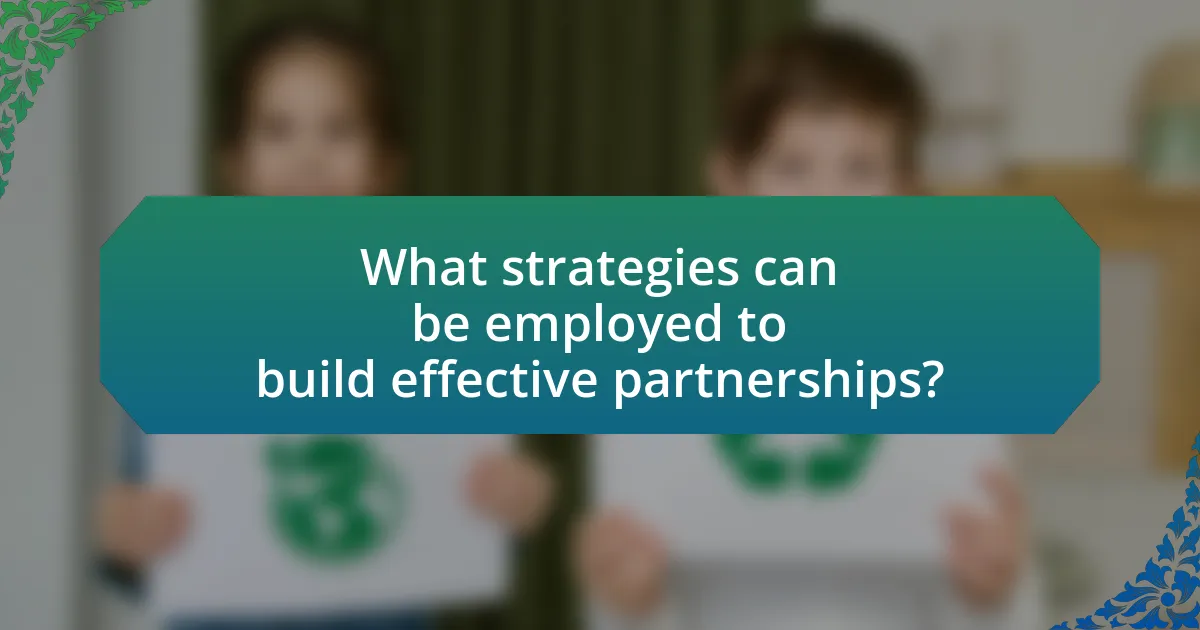
What strategies can be employed to build effective partnerships?
To build effective partnerships, organizations should prioritize clear communication, shared goals, and mutual benefits. Clear communication ensures that all parties understand each other’s expectations and objectives, which is essential for collaboration. Establishing shared goals aligns the efforts of both nonprofits and renewable energy initiatives, fostering a sense of purpose and direction. Additionally, identifying mutual benefits creates a foundation for a sustainable partnership, as both entities can leverage each other’s strengths and resources. Research indicates that partnerships with defined roles and responsibilities, as well as regular check-ins, enhance collaboration and lead to successful outcomes in joint initiatives.
How can nonprofits identify suitable renewable energy partners?
Nonprofits can identify suitable renewable energy partners by conducting thorough research on potential collaborators’ expertise, track record, and alignment with their mission. This involves evaluating partners based on their experience in renewable energy projects, financial stability, and commitment to sustainability. For instance, organizations like the Solar Energy Industries Association provide resources and directories that can help nonprofits find reputable companies in the renewable sector. Additionally, nonprofits should seek partners with a proven history of successful projects, as evidenced by case studies or testimonials, to ensure reliability and effectiveness in collaboration.
What criteria should be used to evaluate potential partners?
To evaluate potential partners in the context of fostering partnerships between nonprofits and renewable energy initiatives, the criteria should include alignment of mission, capacity for collaboration, and track record of success. Alignment of mission ensures that both organizations share common goals, which is crucial for effective partnership. Capacity for collaboration assesses the partner’s ability to work together, including resources, expertise, and willingness to engage. A track record of success provides evidence of the partner’s effectiveness in previous initiatives, indicating reliability and potential for achieving shared objectives. These criteria are essential for establishing productive and sustainable partnerships in the renewable energy sector.
How can nonprofits approach renewable energy initiatives for collaboration?
Nonprofits can approach renewable energy initiatives for collaboration by identifying shared goals and aligning their missions with those of renewable energy organizations. This alignment can facilitate partnerships that leverage resources, expertise, and networks to promote sustainable energy solutions. For instance, nonprofits focused on environmental conservation can collaborate with renewable energy companies to develop community solar projects, which not only provide clean energy but also engage local populations. Research indicates that partnerships between nonprofits and renewable energy sectors can enhance project visibility and funding opportunities, as seen in successful initiatives like the Solar Energy Industries Association’s collaborations with various nonprofit organizations to promote solar adoption across communities.
What role does communication play in fostering these partnerships?
Communication is essential in fostering partnerships between nonprofits and renewable energy initiatives as it facilitates understanding, alignment of goals, and collaborative problem-solving. Effective communication ensures that both parties share their visions, resources, and expertise, which is crucial for building trust and commitment. Research indicates that organizations with strong communication practices are 25% more likely to achieve successful partnerships, as they can navigate challenges and leverage opportunities more effectively. This alignment through clear dialogue enhances the potential for innovative solutions and sustainable outcomes in renewable energy projects.
How can effective communication strategies enhance collaboration?
Effective communication strategies enhance collaboration by ensuring clarity, fostering trust, and facilitating the exchange of ideas among team members. Clear communication minimizes misunderstandings, which can lead to more efficient decision-making and problem-solving. For instance, a study by the Project Management Institute found that organizations with effective communication practices are 50% more likely to complete projects on time and within budget. This demonstrates that when communication is prioritized, collaboration becomes more productive and aligned with shared goals.
What tools can be used to facilitate ongoing dialogue?
Tools that can be used to facilitate ongoing dialogue include communication platforms, collaborative software, and social media channels. Communication platforms like Zoom and Microsoft Teams enable real-time discussions and meetings, fostering direct interaction. Collaborative software such as Slack and Trello allows teams to share updates, documents, and feedback efficiently, promoting continuous engagement. Social media channels, including Facebook and Twitter, provide a space for broader outreach and community involvement, encouraging dialogue beyond formal settings. These tools enhance transparency and accessibility, which are crucial for building and maintaining partnerships between nonprofits and renewable energy initiatives.
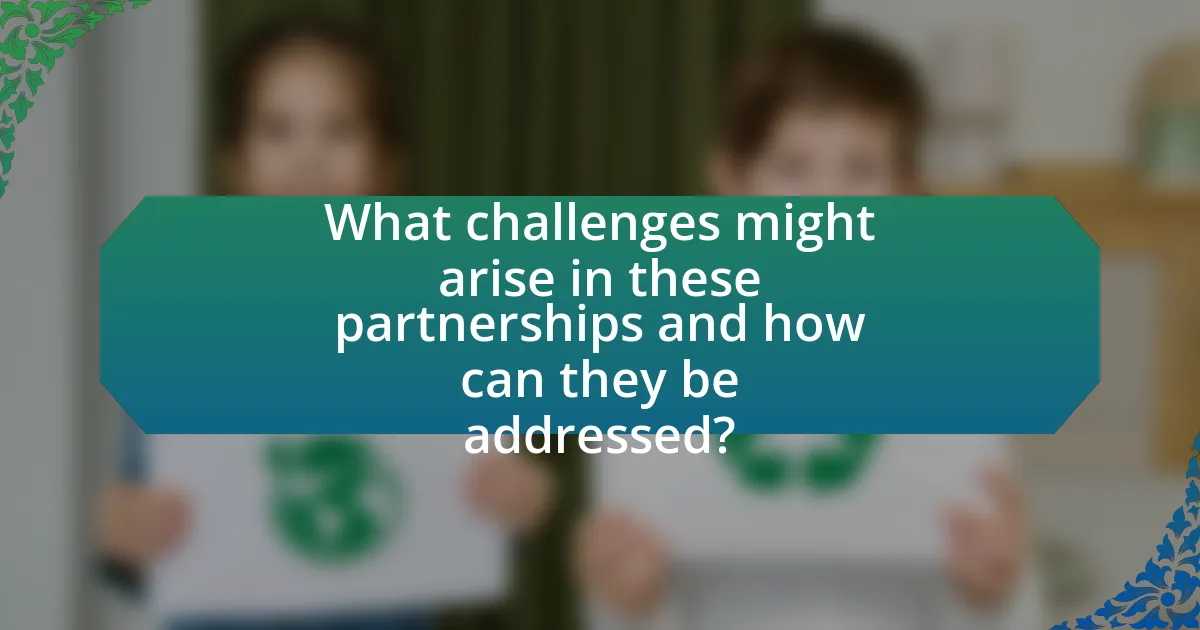
What challenges might arise in these partnerships and how can they be addressed?
Challenges in partnerships between nonprofits and renewable energy initiatives include misaligned goals, resource constraints, and communication barriers. Misaligned goals can lead to conflicts in project priorities; addressing this requires establishing clear, shared objectives from the outset. Resource constraints, such as limited funding or expertise, can hinder project implementation; nonprofits can mitigate this by leveraging grants and forming coalitions to pool resources. Communication barriers may result in misunderstandings; regular meetings and transparent reporting can enhance collaboration and ensure all parties are informed and engaged.
What common obstacles do nonprofits face when partnering with renewable energy initiatives?
Nonprofits commonly face funding limitations when partnering with renewable energy initiatives. Many nonprofits operate on tight budgets, making it challenging to allocate resources for renewable energy projects, which often require significant upfront investment. Additionally, there may be a lack of technical expertise within nonprofits to navigate the complexities of renewable energy technologies and policies. This gap can hinder effective collaboration and implementation of projects. Furthermore, regulatory barriers and lengthy approval processes can delay project timelines, creating frustration and uncertainty for nonprofits seeking to engage in renewable energy initiatives.
How can differing organizational cultures create challenges?
Differing organizational cultures can create challenges by leading to misunderstandings and conflicts in communication and collaboration. For instance, a nonprofit focused on community engagement may prioritize relationship-building, while a renewable energy initiative might emphasize efficiency and results. This divergence can result in misaligned goals and expectations, hindering effective partnership development. Research indicates that 70% of partnerships fail due to cultural misalignment, highlighting the importance of addressing these differences to foster successful collaborations.
What are the financial risks involved in these partnerships?
The financial risks involved in partnerships between nonprofits and renewable energy initiatives include funding instability, project cost overruns, and potential misalignment of financial goals. Funding instability arises when grants or donations fluctuate, impacting the sustainability of the partnership. Project cost overruns can occur due to unforeseen expenses, leading to budget shortfalls. Additionally, misalignment of financial goals may result in conflicts over resource allocation and investment priorities, jeopardizing the partnership’s effectiveness. These risks can hinder the successful implementation of renewable energy projects and affect the overall mission of the nonprofit organization.
How can nonprofits overcome these challenges?
Nonprofits can overcome challenges in fostering partnerships with renewable energy initiatives by actively engaging in collaborative efforts and leveraging shared resources. By establishing clear communication channels and aligning their missions with the goals of renewable energy projects, nonprofits can create mutually beneficial partnerships. For instance, a study by the National Renewable Energy Laboratory highlights that nonprofits that engage in joint ventures with energy companies can access funding and technical expertise, which enhances their operational capacity and impact. Additionally, nonprofits can advocate for policy changes that support renewable energy initiatives, thereby positioning themselves as key stakeholders in the transition to sustainable energy solutions.
What best practices can be implemented to mitigate risks?
To mitigate risks in partnerships between nonprofits and renewable energy initiatives, organizations should implement thorough risk assessments, establish clear communication channels, and create formal agreements outlining roles and responsibilities. Conducting risk assessments allows organizations to identify potential challenges and develop strategies to address them proactively. Clear communication ensures that all parties are aligned on goals and expectations, reducing misunderstandings that could lead to conflicts. Formal agreements provide a legal framework that protects the interests of both parties and clarifies the scope of the partnership, which is essential for accountability and transparency. These practices are supported by research indicating that structured partnerships with defined roles and open communication significantly enhance project success rates in the renewable energy sector.
How can conflict resolution strategies be effectively applied?
Conflict resolution strategies can be effectively applied by utilizing collaborative approaches that prioritize open communication and mutual understanding. These strategies involve identifying the underlying interests of all parties, facilitating dialogue to address concerns, and working towards a consensus that benefits both nonprofits and renewable energy initiatives. Research indicates that successful conflict resolution often leads to stronger partnerships, as evidenced by a study published in the Journal of Conflict Resolution, which found that organizations that engage in collaborative conflict resolution experience a 30% increase in partnership satisfaction.
What are some practical tips for nonprofits to successfully engage with renewable energy initiatives?
Nonprofits can successfully engage with renewable energy initiatives by forming strategic partnerships with local energy providers and leveraging community resources. Establishing collaborations allows nonprofits to access expertise, funding, and technology that can enhance their renewable energy projects. For instance, nonprofits can partner with solar companies to facilitate community solar programs, which can increase local energy access while promoting sustainability. Additionally, nonprofits should actively participate in renewable energy workshops and forums to network with industry leaders and stay informed about the latest trends and technologies. Engaging in advocacy efforts to promote supportive policies for renewable energy can also amplify their impact and attract more stakeholders. According to a report by the National Renewable Energy Laboratory, community engagement significantly boosts the success rate of renewable energy projects, highlighting the importance of collaboration and advocacy in this sector.
How can nonprofits create a compelling value proposition for potential partners?
Nonprofits can create a compelling value proposition for potential partners by clearly articulating their mission, demonstrating impact, and aligning goals with those of the partners. By showcasing specific outcomes, such as increased community engagement or measurable environmental benefits, nonprofits can illustrate their effectiveness. For instance, a nonprofit focused on renewable energy might present data showing how their initiatives have reduced carbon emissions by a certain percentage, thereby appealing to partners interested in sustainability. Additionally, aligning the nonprofit’s objectives with the strategic interests of potential partners, such as shared values in environmental stewardship, enhances the attractiveness of the partnership. This approach not only highlights mutual benefits but also fosters trust and collaboration, essential for successful partnerships.
What steps should nonprofits take to ensure sustainable partnerships?
Nonprofits should establish clear communication and shared goals to ensure sustainable partnerships. By defining mutual objectives, nonprofits can align their missions with those of their partners, fostering collaboration. Regularly scheduled meetings and updates help maintain transparency and trust, which are crucial for long-term relationships. Additionally, nonprofits should evaluate the partnership’s impact through measurable outcomes, ensuring that both parties benefit and adapt as needed. Research indicates that partnerships with defined roles and responsibilities lead to higher success rates, as seen in various nonprofit collaborations in the renewable energy sector.


